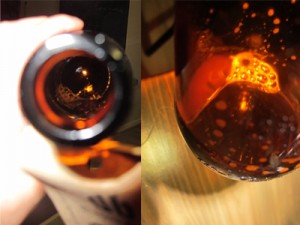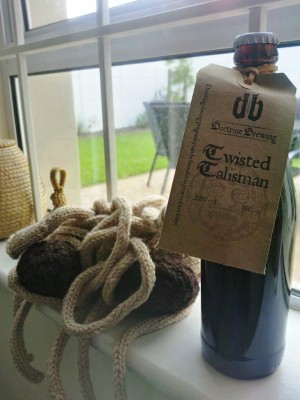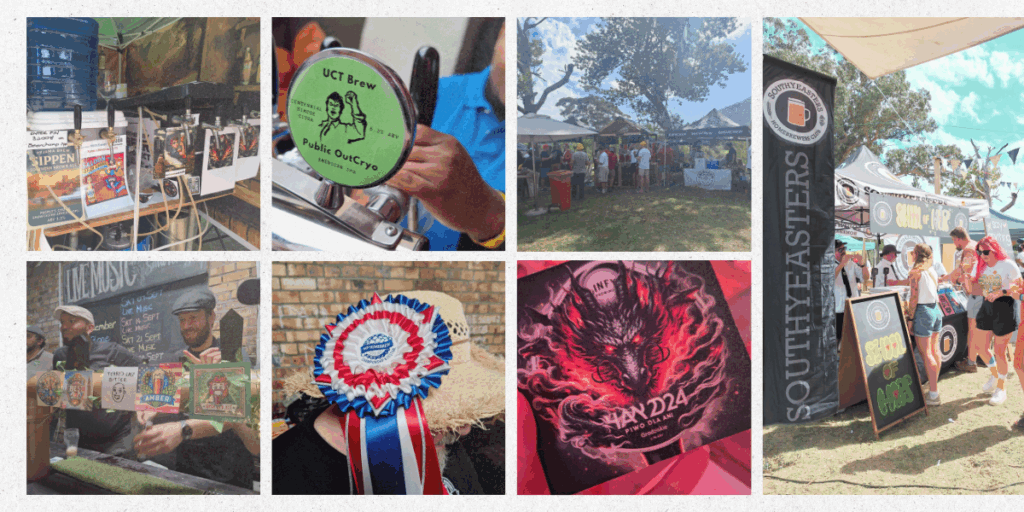It’s been a gentle start to the year – the obligatory January posts rounding up last year and looking forward to 2016. But now the kids are back at school, the gloves are off and it’s time for a rant. On the agenda: the topic of beer shelf life and whether the kak beer you bought is being tipped down your sink because the vendor didn’t store it correctly or because the brewer didn’t do a good job in the first place.
 If you’ve ever had the misfortune of buying a beer that turned out to be undrinkable muck, and you contacted the brewer with your concerns, you might have heard the excuses. “It was perfect when it left the brewery. People don’t respect the cold chain. Liquor store owners/bar owners don’t understand craft beer/bottle-conditioned beer. We tell them they have to keep it cold but they leave it out of the fridge and there’s not much we can do about it.” Most of these comments are true. Bottles are often left on shelves or in non-refrigerated storerooms while they wait for a spot in the fridge. And short of turning up every day and asking the vendors to put their beer back in the fridge, there’s not much a brewer can do about it. But do they really need to do anything about it? Is it really so bad to leave a case of unfiltered, unpasteurised beer at room temperature for a while? I teamed up with Doctrine Brewing in Pietermaritzburg to conduct a little experiment.
If you’ve ever had the misfortune of buying a beer that turned out to be undrinkable muck, and you contacted the brewer with your concerns, you might have heard the excuses. “It was perfect when it left the brewery. People don’t respect the cold chain. Liquor store owners/bar owners don’t understand craft beer/bottle-conditioned beer. We tell them they have to keep it cold but they leave it out of the fridge and there’s not much we can do about it.” Most of these comments are true. Bottles are often left on shelves or in non-refrigerated storerooms while they wait for a spot in the fridge. And short of turning up every day and asking the vendors to put their beer back in the fridge, there’s not much a brewer can do about it. But do they really need to do anything about it? Is it really so bad to leave a case of unfiltered, unpasteurised beer at room temperature for a while? I teamed up with Doctrine Brewing in Pietermaritzburg to conduct a little experiment.
The Experiment
Dion from Doctrine is a friend of mine. A friend who is also a proponent of bottle-conditioning. And one who took me to task on my rant on the pitfalls of this process back in 2014. He was determined to prove that bottle-conditioning, when done well, is a fine way to carbonate a beer. I don’t disagree. In fact I was never against the process itself – most Belgian beers are beautifully bottle-conditioned, as are many ales from my native UK. My issue was with brewers who don’t understand or follow the process, who see it simply as a way to save some money on a bottle filler rather than what it is – a science-based art form.
So Dion shipped a six-pack of his Baltic porter, Twisted Talisman, to me and so the experiment began. It was great to use a beer from the other side of the country for this, for we could also test out the old “craft beer doesn’t travel well” chestnut as well. Dion’s bottles of porter travelled about 1600km from brewery to my house, and no, they did not travel on ice nor in a refrigerated truck.
The batch – a 7% ABV porter fermented with a lager yeast – was brewed on May 1st 2015 and bottled five weeks later on June 6th. It spent the first couple of months of its life in a cold room at 15-17 degrees C and arrived in Cape Town on August 1st. I divvied up the bottles – some in the fridge and others in the cupboard and waited another month before cracking open the first bottle.

No yeast cake/yeast kak!
The First Taste
It was 7th September when I first sipped the Twisted Talisman. It’s a very pretty beer, deep mahogany, solid ruby highlights and an off-white head. There was nothing untoward on the nose – hints of chocolate and a touch of coffee. No off aromas, but then I didn’t expect any as this beer had been in my fridge the whole time. Plus Dion is great brewer with an admirable fear of infection in his brewhouse. I started to wish we’d started this experiment in winter – from the first sip, I wanted to eat chocolate fondant by a roaring fire. The beer has a hit of booze and subtle coffee flavours, followed by a long, lingering bitterness It’s kind of like ending the evening with an Irish coffee, except better, because it’s beer. I’m not a fan of the old “it’s bottle-conditioned so you have to leave a couple of centimetres in the bottle” excuse, so I poured out the whole thing. “As long as you are not throwing the bottles around I’m confident that you can pour the last drop into your glass with only a hint of yeast coming right at the very end,” Dion had said, and he was correct. The last inch poured cloudy, leaving minimal yeast residue in the bottle. (I spent a while attempting to capture this in photographic form, with limited success – see above).
A month later, we opened bottle number two, which had been kept in a cupboard until the day before we opened it. My scribblings are fairly – what’s the opposite of noteworthy? Noteworthless?? They’re fairly noteworthless.There were again no off flavours, and it basically exhibited the same aroma and flavour characteristics of its predecessor.

The abused beer: kept on a sunny windowsill for a week
Some extreme heat
Then we decided to take it up a notch. for November there would be two bottles – one stored in a cupboard, then moved to the fridge the day before drinking, the other given a real beating. It sat on my office windowsill for a week in full sun. The temperature reached the high 20s for a few days in a row and that particular window gets a lot of sun – just ask the Flying Spaghetti Monster. The beer was then moved to the fridge for a week and opened on November 2nd.
Now we started to notice some changes. The unabused bottle again gave a touch of dark chocolate and some coffee but also started to take on a more complex character – plums, molasses and a touch of dried fruit. The latter is often associated with an aged beer and can be a sign of oxidation, though it’s also an acceptable flavour for this style. The poor beast that spent a week on the windowsill did not fare so well. The sun had certainly sped up the ageing process, just as it does to human skin. Dried fruit aromas rose and along with them we spotted the wet cardboard character associated with older beers as well as a background meatiness. The beer also seemed thinner, less full-bodied and was certainly less enjoyable. But what it was not was sour. Nor chlorophenolic. Nor butyric, astringent or full of floating clumps of yeast. In short it had aged very quickly, but a beer that was clean to begin with does not suddenly develop nasty off flavours just because it is warmed up a little (OK, a lot).
For more on the effect of temperature on the ageing rate of beer, read this.
Getting better with age
A month later, on December 8th, we opened the fifth bottle – brewed seven months earlier, transported 1600km and never introduced to the inside of a fridge until a day before it was to be drunk. A surprise was in store for us. The coffee-coloured head fell fairly quickly and the beer appeared to be slightly more highly carbonated than before. And the beer had changed. It was richer, tastier, way more complex and definitely full of festive flavours – plum pudding, toffee, chocolate and to back it up, that subtle taste of coffee. I was still enjoying a long taste of treacle toffee five minutes later, making this quite probably the most enjoyable bottle of them all. (Note: I took the sixth bottle to a tasting but alas didn’t actually get a sip). There was no oxidation to speak of and curiously (or not), the beer had not turned into a sour mess despite spending the majority of its life around the 20-degree mark.
 Of course, some beer styles age better than others, and a Baltic porter at 7% is going to be a better candidate than a blonde ale. But this wasn’t really an experiment in ageing beer and the flavours this process develops – that was just an interesting by-product. It was an experiment looking at storage conditions and whether an unfiltered, bottle-conditioned beer needs to be stored at fridge temperatures at all times. It was an attempt to prove that a beer does not suddenly turn from being “perfectly fine at the brewery” to being a masterclass in off flavours just because the owner of a liquor store kept it on a shelf rather than in the fridge. And I’m happy with the results.
Of course, some beer styles age better than others, and a Baltic porter at 7% is going to be a better candidate than a blonde ale. But this wasn’t really an experiment in ageing beer and the flavours this process develops – that was just an interesting by-product. It was an experiment looking at storage conditions and whether an unfiltered, bottle-conditioned beer needs to be stored at fridge temperatures at all times. It was an attempt to prove that a beer does not suddenly turn from being “perfectly fine at the brewery” to being a masterclass in off flavours just because the owner of a liquor store kept it on a shelf rather than in the fridge. And I’m happy with the results.
Don’t stand for off beer – take it up with the brewer and make sure you get a replacement. It’s the only way the industry is going to grow. And if you get the chance, taste Doctrine’s Baltic porter. It’s really very good.










The thing that some “craft” brewers forget: Beer gets infected at the brewery, no where else. (Dirty serving lines excluded). As simple as that. Blaming someone else because you can’t sanitize is just a shitty move.
Thanks for giving me a chance to do this experiment with you.
I do take every precaution I can to prevent infection, but still the moment the beers were shipped a sense of dread set i; what if they did go bad. Then you put that bottle on the windowsill for a week and I really wondered if I had done the right thing. 😉
That sense of dread is a good thing; as a commercial brewer I hope I don’t ever lose it.
Thanks for suggesting the experiment and providing the beers Dion. And for being brave enough to do it!!
I agree with all of the above. We have had some of our homebrewed batches age in bottle for more than a year. Trying some every couple of months. Very interesting to see how the flavours develop and change, especially in richer beer styles like Stouts an Porters. We are by no means master Belgian brewers who know all the intricacies of bottle conditioning, we are however clean. We check and double check that everything the beer touches has been cleaned with sanitizer. I also agree that some beers might get skunked along the supply chain. But in my opinion a beer that is infected, is the brewers fault. They should be made aware of it and take it upon themselves to ensure it doesn’t happen again. I have spent way too much money buying infected beers from new local breweries, to the point that a rarely buy a brand new local beer, much rather go for a trusted local brand or imports.
It’s sad but true Frans – I’m always hesitant to fork out for a beer from a new brewery or even more so from a brewery where I’ve already had a bad experience. Let’s hope that by this time next year we can happily pick up any beer of the shelf and know that it will be good!!
Great piece – thanks LC & DvH! LC if you want to run a similar “side by side” on my (hopefully clean, thanks to Apiwe et al) beer with its fynbos antioxidants, I’d be happy to send you some. Let me know.
Sounds like a good idea. I’m thinking of getting a few brewers on board and doing a six-month or even year-long test… Will keep you posted!
Agree with all of above but as mentioned, lighter style beers such as blondes/Weiss etc will be more negatively affected by age. Higher alcohol (esp darker variety) beers are usually associated with better maturation potential.
Would be great to repeat this experiment with a Blonde or Weiss – even a lower alc IPA.
Let’s do it! I’ll see if I can get samples of a lager, blonde ale, weiss and IPA donated!!
The summer was early and rough , driest year in SA in 112 years ….that being said ,if a customer give you troubling feedback… you can either up your game or lower your standards …. but that’s the only two choices you have . i had sleepless nights knowing the beer is going to be in a boot ,back of a car … not everyone see beer as the Elixir of life. i will still keep bottle carbonated beers …lov it , but not all styles . agree with Sean .. 2min noodles for me this year , but im getting a DME keezel.
Great article and experiment.
A while back I was pondering the dilemma of something like a Weiss or a lighter color style beer with the aging process. I just happened to be sipping on a beer from one of our fellow German brewers (very well known and Lucy mentioned him in her great book – enough of a clue) and noticed something different with his hopping schedule. I was curious and got in touch with him and he pointed me to the best before date on the bottle. He did confirm that they had tweaked the recipe etc.
A long story short, I could not believe the incredibly long shelf life, especially as there is no filtering or pasteurization as advertised on their bottles. When I asked him about this, he indicated that their incredible shelf life and stability has to do with how they mature their beer. Now I didn’t know how much of a sales gimmick or how much truth to this there was – they lager their bottled beer for a period before shipping, so I took it all with a pinch of salt at the time.
Armed with this, I approached a chemist buddy of mine (an avid home brewer too) to put the theory to him. After a lot of talk about colloids (all if which is way above my head), the chemist buddy confirmed that in theory that this is possible. Being a humble engineer turning pro-brewer, I looked into this in more detail to find something that would indeed make sense and not seem to be too much gibberish to us non-chemist people.
Beer shelf life has to do with colloidal stability, or rather colloidal instability. It seems that the German brewers were on to this many years before they understood the science. Ever think about how and when they brewed their lagers? How long it lasted before they even drank it? The colloidal instability (If I have this right, we would want to knock these colloid particles out of the beer i.e. cause them to settle) is achieved through a few things, fining, temperature change and or filtering. Finings are easily understandable. Filtering the same. Temperature change – think pasteurization – raising the temperature sharply and cooling quickly knocks the colloids out. The inverse is also true – dropping the temperature and holding it low for a period of time also does the same thing, it just takes longer.
So those Germans were onto something all those years ago. And it seems that their secret is carried through to modern brewers today, although they are not telling unless you ask the right questions. And even then, I was only lucky because I asked something completely unrelated and then got sidetracked to their shelf life.
I do not know how long the fellow German brewer lagers the beers for and did not think to ask for a time frame. I do think that this would be a good experiment though.
As to infected beers, there is no excuse for that – it comes from the brewery. If you buy a perfectly good beer and there are no tell tale signs, crown has been nicked or something like that, it comes from the source.
Stale beer, I am also going to blame the brewer here. I have had my say on facebook worthogs regarding this where I took the stance of defending the brewers for stale beer, but on reflection I am not convinced any more. I recently opened one of my Weiss beers that I had brewed almost two years ago. It was only just starting to signs of oxidization, nevertheless very drinkable. This beer was not kept anywhere special, just a spare room floor. I had a Wit from another brewer and tweeted it as I do, the brewer came back very quickly to me and asked why this particular publican still had the beer in stock as it was over a year and a half ago that they brewed it. Nevertheless, this bottled Wit was only starting to show slight signs of oxidization.
We as brewers know that staling is accelerated by aeration anywhere from the hot side, through after fermentation has been completed. This can come during the bottling process when care is not taken, faulty bottling lines etc. Again it comes from the brewery. There is no way that you can convince me that a normal strength lager or ale, that has been brewed with care, bottled correctly can be stale within less then three months of it’s born by date.
Sorry for the long post, but I think it is some insight into something that has baffled me for a long time and apologize to all that were already aware of this. And my two cents rant on the state of paying good money for a roulette chance that the beer you buy might actually be drinkable.
A question that we should all ask ourselves if we distribute – the beers being brewed by the overseas contingent are not treated any differently from our own with regards to transport handling etc when it comes to the bottle store, but they seem to outlast ours, why?
Cheers
Craig
Thanks for taking the time to comment at length Craig. Some great info in there and some excellent points. I do think that one of the problems with some of the smaller breweries is that they’re rushing the beer out to get the cash flow in and to make space in the fermenters/cold room for the next batch. A lot of issues could be solved if the yeast were given more time to “clean up after themselves” I think. And as you say, a maturation period could do wonders for the stability of the beer.
You, no doubt have experienced Fullers Vintage Ale. Thus wonderful independent brewery can teach almost everyone about ageing and bottle conditioning to perfection.